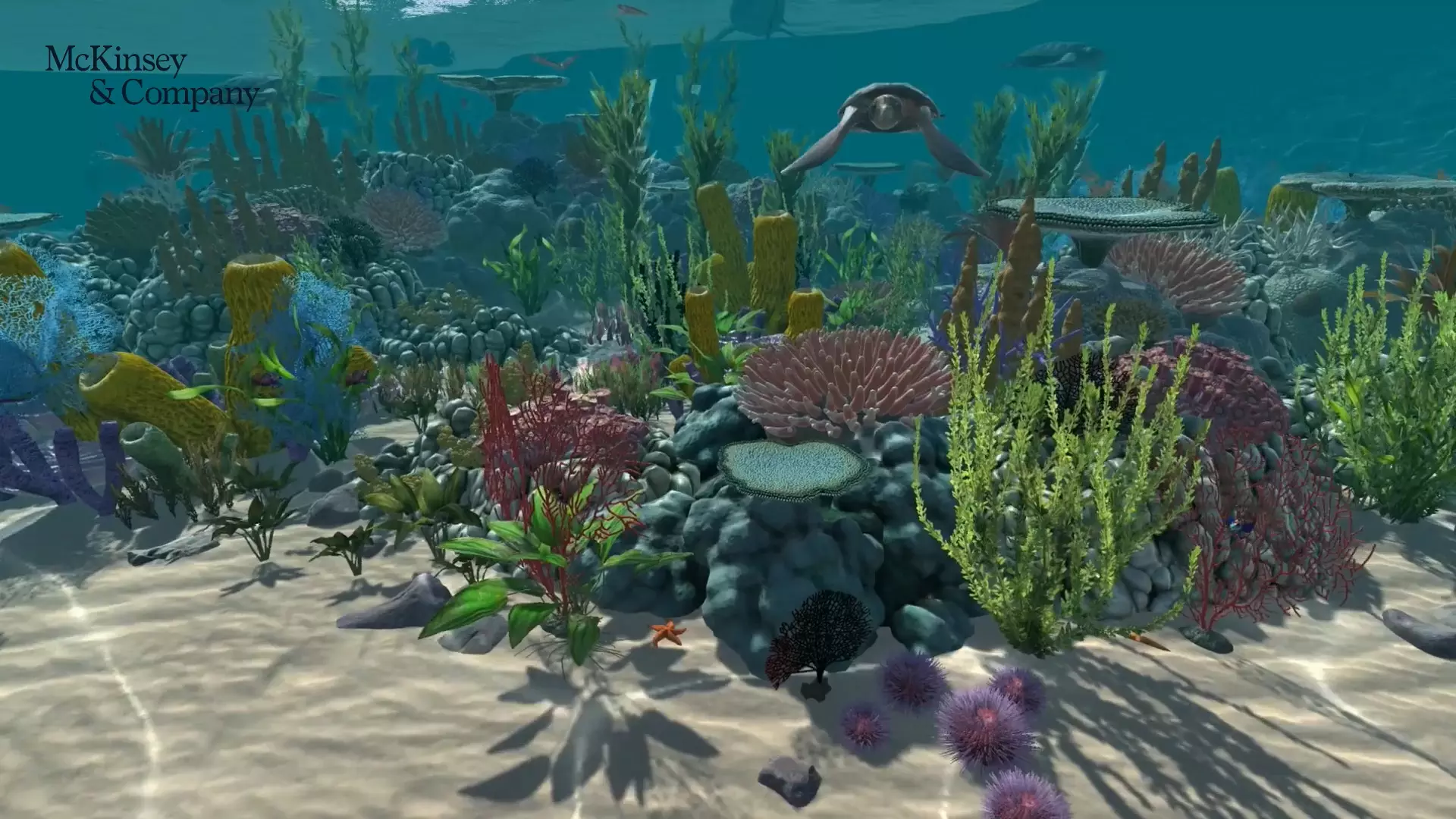
McKinsey’s Solve assessment has been making candidates sweat ever since it was initially trialled at the firm’s London office back in 2017 - and things have gotten even more difficult since a new version launched in Spring 2023, adding the Redrock case study and trialling the Ocean Cleanup in 2024.
In Summer 2023, we have seen a new iteration of that Redrock case, as we continue to interview test takers to keep you updated. This replaces the case study about optimising wolf pack populations across Redrock Island with one about boosting the overall plant biodiversity on the same island.
Since its initial roll-out, the Solve assessment has definitely been the most idiosyncratic, but also the most advanced, of the screening tests used by the MBB firms.
It can be hard to understand how an ecology-themed video game can tell McKinsey whether you’ll make a good management consultant, let alone know how to prepare yourself to do well in that game. When you consider that McKinsey are potentially cutting 70%+ of the applicant pool based on this single test, you can hardly blame applicants for being worried.
Matters are definitely not helped by the dearth of reliable, up-to-date information about what could very well be - with a top-tier consulting job on the line - the most important test you will take over your entire career. This was already true with the version of Solve that had been around for a few years, let alone the new iterations.
What information is available online is then often contradictory. For a long time, there was huge disagreement as to whether it is actually possible to meaningfully prepare for the Solve assessment - before you’ve even considered how to go about that preparation. There is also a lot of confusion and inaccuracy around the new Redrock case - largely as it is such a recent addition, and individual test takers tend to misremember details.

Luckily, we at MCC have been interviewing test takers both before and after the Redrock case rollout and have been following up to see which strategies and approaches actually work to push individuals through to interview.
Here, we’ll explain that it is indeed possible to prepare effectively for both versions of Solve and give you some ideas for how you can get started. Understanding how the Solve assessment works, what it tests you for and how is critical for all but the most hurried preparations.
This article makes for a great introduction to the Solve assessment. However, if you are going to be facing this aptitude test yourself and want full information and advice for preparation, then you should ideally get our full PDF guide:

In simple terms, the McKinsey Solve assessment is a set of ecology-themed video games. In these games, you must do things like build food chains, protect endangered species, manage predator and prey populations, boost biodiversity and potentially diagnose diseases within animal populations or identify natural disasters.
Usually, you will be given around 70 minutes to complete two separate games, spending about the same amount of time on each.
Until recently, these games had uniformly been Ecosystem Building and Plant Defence. However, since Spring 2023, McKinsey has been rolling out a new version across certain geographies. This replaces the Plant Defence game with the new Redrock case study. Some other games have also been run as tests.
We’ll run through a little more on all these games below to give you an idea of what you’ll be up against for both versions and possible new iterations.
An important aspect that we'll cover in more detail here is that the Solve games don't only score you on your answers (your "product score"), but also on the method you use to arrive at them (your "process score") - considerably impacting optimal strategy.
In the past, candidates had to show up to a McKinsey office and take what was then the Digital Assessment or PSG on a company computer. However, candidates are now able to take the re-branded Solve assessment at home on their own computers.
Test takers are allowed to leverage any assistance they like (you aren’t spied on through your webcam as you would be with some other online tests), and it is common to have a calculator or even another computer there to make use of.
Certainly, we strongly advise every candidate to have at least a pen, paper and calculator on their desk when they take the Solve assessment.
In short, yes - “Solve” is just the newer name for the McKinsey Problem Solving Game.
We want to clear up any potential confusion right at the beginning. You will hear this same screening test called a few different things in different places. The Solve moniker itself is a relatively recent re-branding by McKinsey. Previously, the same test was known as either the Problem Solving Game (usually abbreviated to PSG) or the Digital Assessment. You will also often see that same test referred to as the Imbellus test or game, after the firm that created the first version.
You will still see all these names used across various sites and forums - and even within some older articles and blog posts here on MyConsultingCoach. McKinsey has also been a little inconsistent on what they call their own assessment internally. Candidates can often become confused when trying to do their research, but you can rest assured that all these names refer to the same screening test - though, of course, folk might be referring to either the legacy or Redrock versions.
It’s useful to understand where the Solve assessment fits into McKinsey’s overall selection process and why they have felt the need to include it.
Let’s dive right in…
McKinsey's own account of how the Solve assessment is used in selection can be seen in the following video:
Whilst some offices initially stuck with the old PST, the legacy Solve assessment was soon rolled out globally and given universally to candidates for roles at pretty well every level of the hierarchy. Certainly, if you are a recent grad from a Bachelor’s, MBA, PhD or similar, or a standard experienced hired, you can expect to be asked to complete the Solve assessment.
Likewise, the new Redrock case study versions seem to be in the process of being rolled out globally - though at this point it seems you might be given either (especially as McKinsey has been having significant technical problems with this new online case study) and so should be ready for both.
At present, it seems that only those applying for very senior positions, or perhaps those with particularly strong referrals and/or connections, are allowed to skip the test. Even this will be office-dependent.
As noted above, one of the advantages of the Solve assessment is that it can be given to all of McKinsey’s hires. Thus, you can expect to be run into the same games whether you are applying as a generalist consultant or to a specialist consulting role - with McKinsey Digital, for example.
The takeaway here is that, if you are applying to McKinsey for any kind of consulting role, you should be fully prepared to sit the Solve Assessment!
You can expect to receive an invitation to take the Solve assessment shortly after submitting your resume.

It seems that an initial screen of resumes is made, but that most individuals who apply are invited to take the Solve assessment.
Any initial screen is not used to make a significant cut of the candidate pool, but likely serves mostly to weed out fraudulent applications from fake individuals (such as those wishing to access the Solve assessment more than once so they can practice. ) and perhaps to eliminate a few individuals who are clearly far from having the required academic or professional background, or have made a total mess of their resumes.
Your email invitation will generally give you either one or two weeks to complete the test, though our clients have seen some variation here - with one individual being given as little as three days.
Certainly, you should plan to be ready to sit the Solve assessment within one week of submitting your resume!
Once you have completed the test, McKinsey explain on their site that they look at both your test scores and resume (in more detail this time) to determine who will be invited to live case interviews. This will only be around 30% of the candidates who applied - possibly even fewer.
One thing to note here is that you shouldn’t expect a good resume to make up for bad test scores and vice versa. We have spoken to excellent candidates whose academic and professional achievements were not enough to make up for poor Solve performance. Similarly, we don’t know of anyone invited to interview who hadn’t put together an excellent resume.
Blunty, you need great Solve scores and a great resume to be advanced to interview.
Your first port of call to craft the best possible resume and land your invitation to interview is our excellent free consulting resume guide.
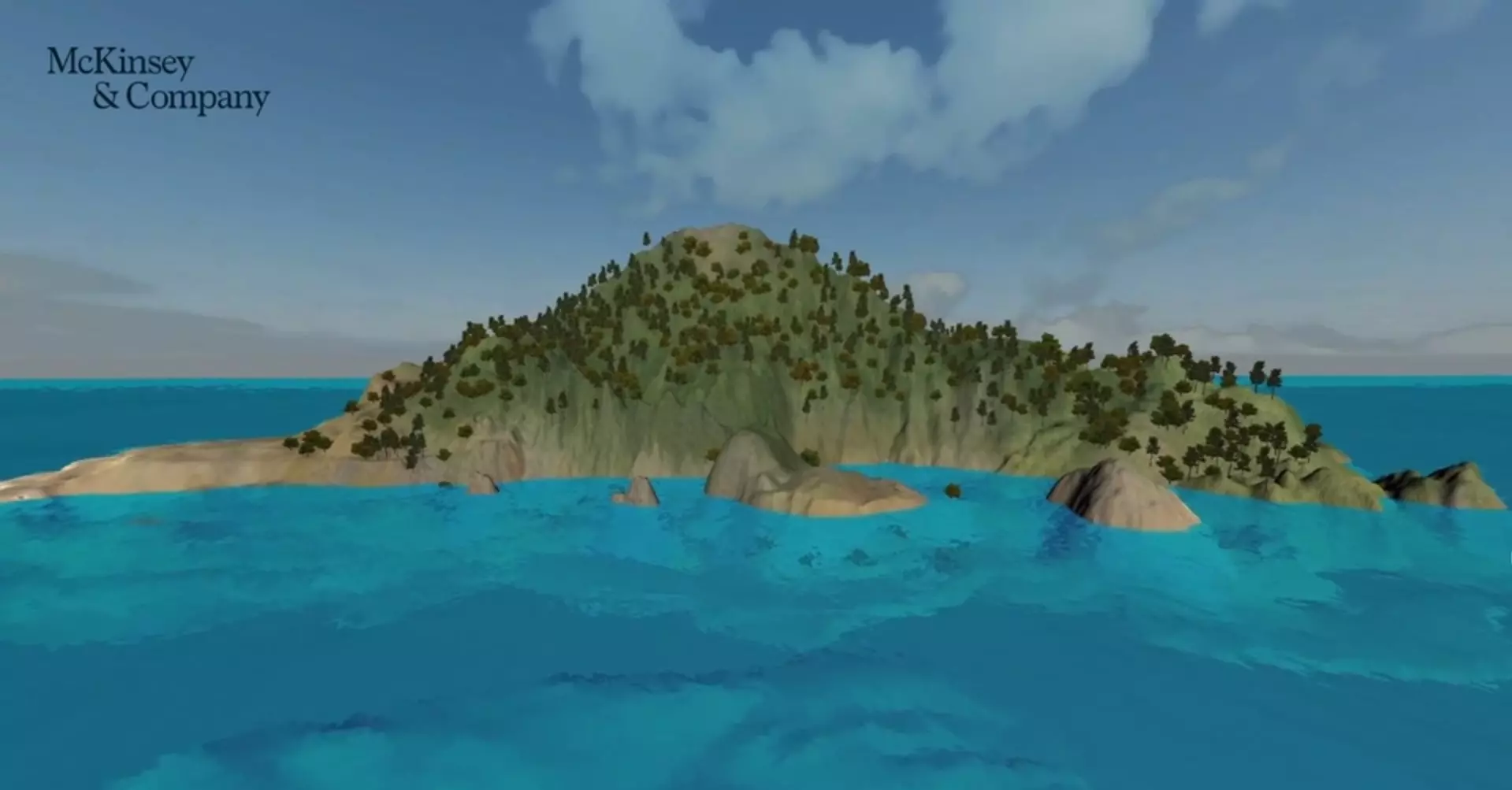
As with Bain, BCG and other major management consulting firms, McKinsey receives far far more applications for each position than they can ever hope to interview. Compounding this issue is that case interviews are expensive and inconvenient for firms like McKinsey to conduct. Having a consultant spend a day interviewing just a few candidates means disrupting a whole engagement and potentially having to fly that consultant back to their home office from wherever their current project was located. This problem is even worse for second-round interviews given by partners.
Thus, McKinsey need to cut down their applicant pool as far as possible, so as to shrink the number of case interviews they need to give without losing the candidates they actually want to hire. Of course, they want to accomplish this as cheaply and conveniently as possible.
The Problem Solving Test (invariably shortened to PST) had been used by McKinsey for many years. However, it had a number of problems that were becoming more pronounced over time, and it was fundamentally in need of replacement. Some of these were deficiencies with the test itself, though many were more concerned with how the test fitted with the changing nature of the consulting industry.
The Solve assessment was originally developed and iterated by the specialist firm Imbellus (now owned by gaming giant Roblox) to replace the long-standing PST in this screening role and offers solutions to those problems with its predecessor.
We could easily write a whole article on what McKinsey aimed to gain from the change, but the following few points cover most of the main ideas:

There has been a bit of variation in the games included in the Solve assessment/PSG over the years and what specific form those games take. Imbellus and McKinsey had experimented with whole new configurations as well as making smaller, iterative tweaks over time. That being said, the 2023 Redrock case studies (seemingly added by McKinsey themselves without Imbellus) are by far the largest change to Solve since that assessment's genesis back in 2017.
Given that innovation seems to continue (especially with the lengthy feedback forms some candidates are being asked to fill in after sitting the newest iteration), there is always the chance you might be the first to receive something new.
However, our surveys of, and interviews with, those taking the Solve assessment - both before and after recent changes - mean we can give you a good idea of what to expect if you are presented with either the legacy or one of the Redrock versions of Solve.
We provide much more detailed explanation of each of the games in our Solve Assessment PDF Guide - including guidance on optimal scenarios to maximise your performance. Here, though, we can give a quick overview of each scenario:
In this scenario, you’re tasked with creating a self-sustaining ecosystem in either an aquatic, alpine, or jungle environment. Additional environments may be introduced without altering the core mechanics. We will use an aquatic (ocean) environment as an example for this article but the same advice is applicable to all other environments in the exact same way.
The enviroment will be chacterised by a number of characteristics. For the ocean, for instance, we will have:
You’ll be given 39 species (both plants and animals) to choose from, each suited to specific environmental conditions, like depth and salinity in an ocean. For a mountain ridge, it could be altitude or sun exposure.
Each species has two main sets of data points:
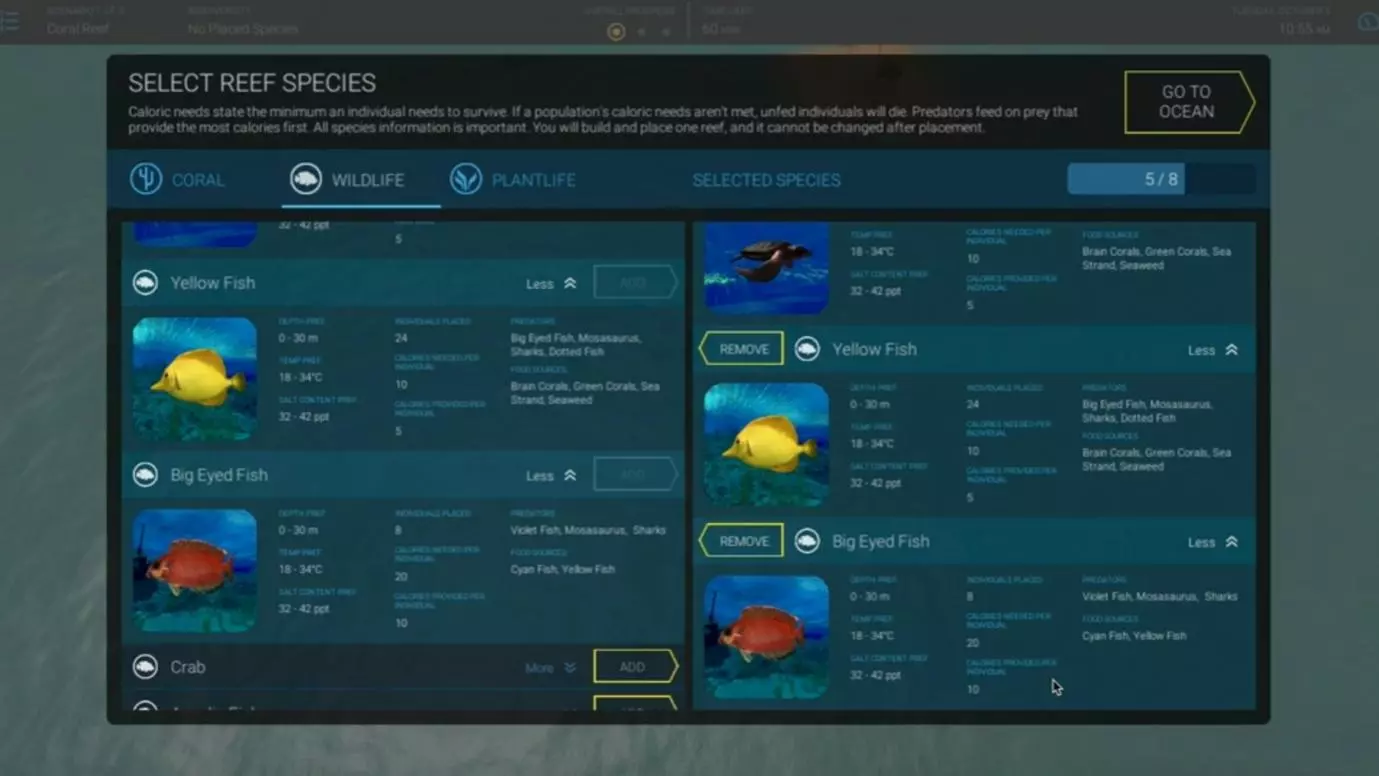
The picture above shows different fishes together with their characteristics. Each card has the following information:
The game requires you to select a location for your ecosystem. Several different options are given, all with different prevailing conditions. You then have to select a number of different plant and animal species to populate a functioning food chain within that location.
In previous versions of the game, you would have had to fit as many different species as possible into a functioning food chain. However, newer iterations of the Solve assessment require a fixed number of eight or, possibly, seven species to be selected. The strategy for the seven species is the same as the one with eight.
Let's look at the game objectives in more details
The former is the actual challenge while the latter is somewhat trivial. Before delving into the strategy, let's outline the eating rules in more details as these are key to successfully tackle the game.
At its core, this game isn’t really a game but more of a logical puzzle administered through a more advanced User Interface (UI). The limited interactions make it a straightforward problem once you understand that the UI is not required and only add complexity. All the essential information could be presented in a table, as shown below, and you could easily solve the puzzle on paper.
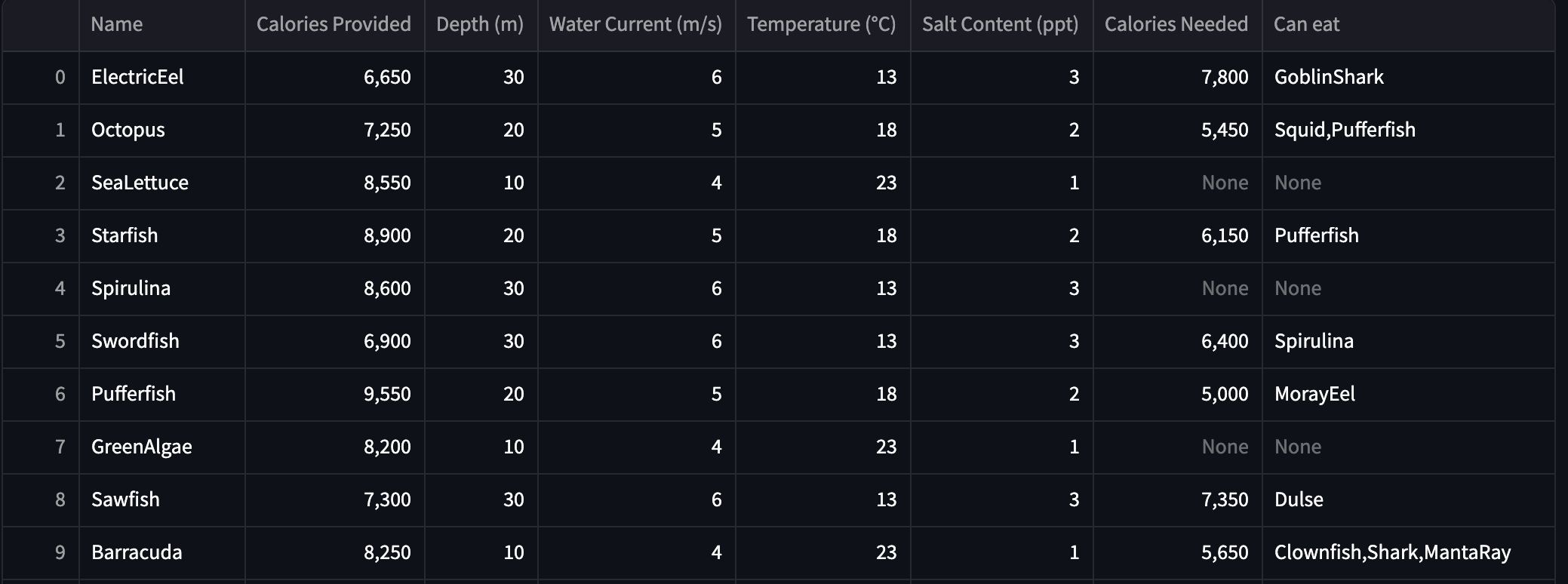
To take abstraction a level further, the problem is in fact a constraint optimisation one. For those of you who are interested (possibly 2 or 3), you can actually model it and solve it analytically. While it does not help in solving the game, I will show the formulation so you can see how this is more of an analytical problem than a game. Entities are
Enough theory, let’s dive into how to solve the game. You’ll be given 39 species, grouped into three sets of 13, each sharing the same environmental constraints like depth and salinity. Each group includes three producers and ten animals.
Your first task is to pick the group most likely to produce a balanced ecosystem. To do this, quickly estimate the total calorie output for all species, check how many animals can consume the producers, and evaluate how many animals are limited to eating other animals. Use your judgment here, as these factors are equally important. Be aware that some combinations won’t lead to a solution.
Once you’ve selected your group, start building the food chain. Ideally, include all three producers (with at least one animal consuming them) as they provide calories without needing any. Then, choose animals that can:
To do this, look at the list of animals that can consume producers without depleting them (there will be one or two), then pick those with the highest calories and that can be eaten by multiple animals. You’ll find this information on the animal card.
Continue adding animals iteratively, checking your solution at every step.
If you don't manage to find a combination, move onto the next group. In order to practice and understand which groups can lead to solutions, you can use our solver.
Once you've established a balanced ecosystem, select a location where the environmental conditions meet the needs of all species. You’re likely to find such a spot. The game provides more conditions than necessary; focus only on the relevant factors mentioned in the species cards. For example, in an ocean scenario, depth and salinity might be crucial, while factors like water speed can be disregarded.
This is done to simulate a consulting scenario where you have more data than needed.
Once you have decided on your food chain, you simply submit it and you are moved on to the next game. In the past, test takers were apparently shown whether their solution was correct or not, but this is no longer the case.
Test takers generally report that this game is the easier of the two, whether it is paired with the Plant Defence game in the legacy Solve or the Redrock case study in the new version. Candidates will not usually struggle to assemble a functioning ecosystem and do not find themselves under enormous time pressure. Thus, we can assume that process scores will be the main differentiator between individuals for this component of the Solve assessment.
So far, this sounds pretty easy. However, the complexity arises from the strict rules around the manner and order in which the different species eat one another. We run through these in detail in our guide, with tips for getting your food chain right. However, the upshot is that you are going to have to spend some significant time checking your initial food chain - and then likely iterating it and replacing one or more species when it turns out that the food chain does not adhere to the eating rules.
For ideas on how to optimise your process score for this game, you can see our PDF Solve guide.
We have also developed the Solve simulator to help you practice effectively. It features a purposedly simple UI, allowing you to focus on mastering the game mechanics. It generates an arbitrary number of scenarios for you to practice on. After a scenario is generated, you can download the data or work directly from the table to select the 13 species most likely to create a balanced ecosystem. You can then submit your solution in a CSV file to check its sustainability. More interestingly, you can explore all possible combinations by uploading a CSV of your selected species to see what works best. The simulator is part of the guide package.
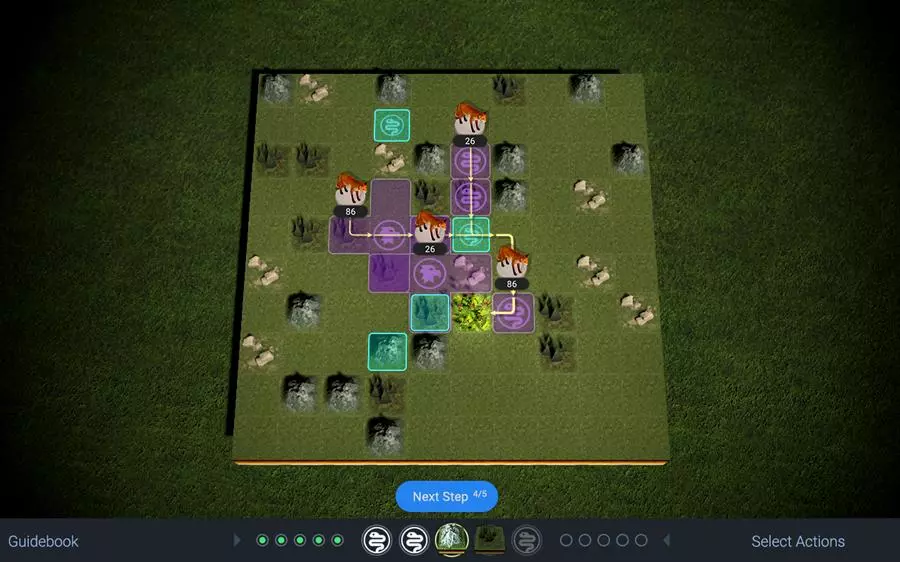
As mentioned, this game has been replaced with the Redrock case study in the new newer version of the Solve assessment, rolled out from Spring 2023 and further iterated in Summer 2023. However, you might still be asked to sit the legacy version, with this game, when applying to certain offices - so you should be ready for it!
This scenario tasks you with protecting an endangered plant species from invasive species trying to destroy it.
The game set-up is much like a traditional board game, with play taking place over a square area of terrain divided into a grid of the order of 10x10 squares.
Your plant is located in a square near the middle of the grid and groups of invaders - shown as rats, foxes or similar - enter from the edges of the grid before making a beeline towards your plant.
Your job then is to eliminate the invaders before they get to your plant. You do this by placing defences along their path. These can be terrain features, such as mountains or forests, that either force the invaders to slow down their advance or change their path to move around an obstacle. To actually destroy the invaders though, you use animal defenders, like snakes or eagles, that are able to deplete the groups of invaders as they pass by their area of influence.
Complication here comes from a few features of the game. In particular:
The plant defence game is split into three mini-games. Each mini-game is further split into three blocks of five turns. On the final turn, the game does not stop, but continues to run, with the invaders in effect taking more and more turns whilst you are not able to place any more defences or change anything about your set-up.
More and more groups of invaders pour in, and your plant will eventually be destroyed. The test with this “endgame” is simply how many turns your defences can stand up to the surge of invaders before they are overwhelmed.
As opposed to the Ecosystem Building scenario, there are stark differences in immediate candidate performance - and thus product score - in this game. Some test takers’ defences will barely make it to the end of the standard 15 turns, whilst others will survive 50+ turns of endgame before they are overwhelmed.
In this context, as opposed to the Ecosystem Building game typically preceding it, it seems likely that product score will be the primary differentiator between candidates.
We have a full discussion of strategies to optimise your defence placement - and thus boost your product score - in our Solve guide.

This is the replacement for the Plant Defence game in the newest iteration of Solve.
One important point to note is that, where the Solve assessment contains this case study, you have a strict, separate time limit of 35 minutes for each half of the assessment. You cannot finish one game early and use the extra time in the other, as you could in the legacy Solve assessment.
McKinsey has had significant issues with this case study, with test takers noting several major problems. In particular:
McKinsey are clearly aware of these issues, as even those sitting the new version of Redrock have been asked to complete substantial feedback surveys. Do note, then, that this raises the likelihood of further changes to the Redrock case study in the near term - meaning you should always be ready to tackle something new.
For the time being, though, we can take you through the fundamentals of the current version of the Redrock case study. For more detail, see our freshly updated PDF Guide.
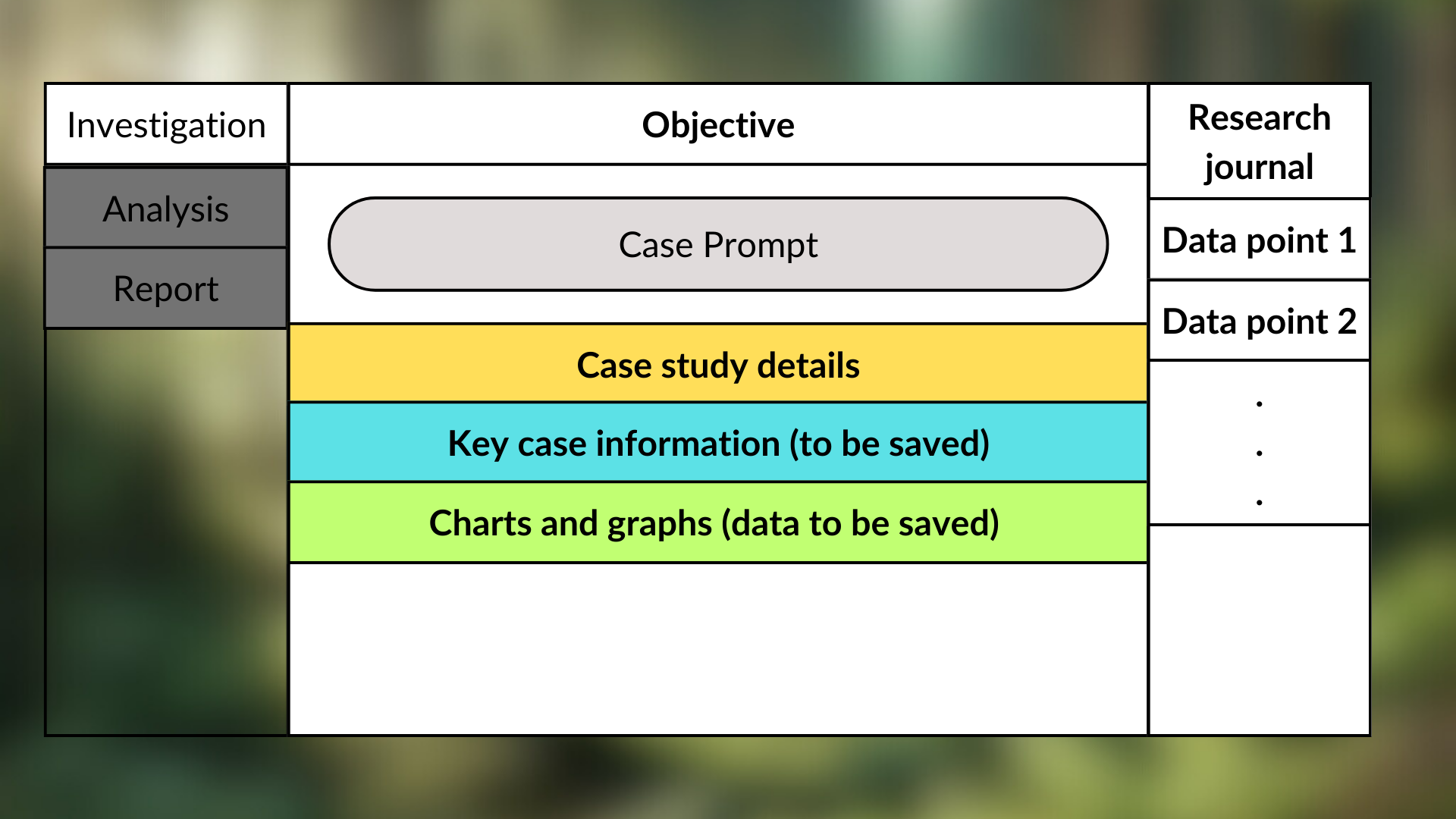
The image above shows a very simple wireframe of the UI used. You will find the main sections on the left, main body at the center and the research journal to the right. In the first section you will need to drag key information and data points from charts to the research journal. In the analysis section you will find the calculator while in the last section you will find charts to choose from.
Whilst changes to the details are likely in future, the current Redrock case study is set on the Island of Redrock. This island is a nature reserve with populations of various species, including wolves, elk and several varieties of plant.
In the original Redrock case, it is explained that the island's wolves are split into four packs, associated with four geographical locales. These packs predate the elk and depend upon them for food, such that there is a dynamic relationship between the population numbers of both species. Your job is to ensure ecological balance by optimising the numbers of wolves in the four packs, such that both wolves and elk can sustainably coexist.
In the newer iteration of the case, first observed in Summer 2023, you are asked to assess which, if any, of three possible strategies can successfully boost the island's plant biodiversity by a certain specified percentage. Plants here are segmented into grasses, trees and shrubs.
The Redrock case study's questions were initially split into three sections, but a fourth was added later. These sections break down as follows:
Visit our Our consulting math page for more details.
Approach this game with a structured, top-down strategy to demonstrate your problem-solving skills. Always label your data clearly to showcase your ability to work with metadata, a crucial skill for consultants. Additionally, minimize back-and-forth actions in the game; although it’s possible in the interface, doing so suggests ineffective data collection and planning.
This is a very brief summary - more detail is available in our PDF Guide. You will also find 100+ Redrock specific exercises for you to practice.
The Ocean Cleanup is a new game that McKinsey began rolling out in the spring of 2024. This game is played after the Solve and Redrock assessments. Although it's not part of the official assessment yet, McKinsey is currently testing it as a potential addition to their suite of evaluation tools. You will still have to sit through the assessment. It does not count towards your final score.
The objective of the Ocean Cleanup game is to identify microbes that can survive in a specific ocean area. While it shares some similarities with the Solve game, particularly in its focus on selecting viable species, it has a different logic.
The first step in the Ocean Cleanup game involves defining attributes (continuous variables) and traits (binary variables) to characterize each ocean area. Attributes might include factors like rigidity or size, while traits could be binary qualities such as being water-repellent or not. These distinctions help in precisely characterizing the environment and determining which microbes are best suited for survival. This process should be relatively straightforward.
Once you selected your variables, you will be given a value for each parameter each ranging from 1 to 10 for 2 sites. You'll be given specific goals, such as 2 for the parameter one, 3 for two, and 8 for the three. You then select up to 4 microbes to match the characteristics of your sites as closely as possible. In each of the 4 rounds, you'll choose 1 microbe from a group of three, aiming to find the best fit for the site's conditions. The system will automatically fill the remaining slots automatically filled to create a total set of 10. This process allows you to strategically build a group of microbes that best meets the objectives.
After selecting your 10 microbes, you’ll narrow it down to 3 that, when averaged, best match your target values. For instance, if your goal is to achieve specific values like 2, 3, and 8, you’d choose microbes where the first parameter is consistently close to 2. For the second parameter, you might opt for values which would average to your target of 3. This strategy ensures that the selected microbes closely align with your desired outcomes. There will be an element of iteration involved since microbes with an average close to parameter 1 may have an average which is off for parameter 3. You will have to repeat this for both sites
Note that the game is still being rolled out so details may change - we will try to keep this page as updated as possible.
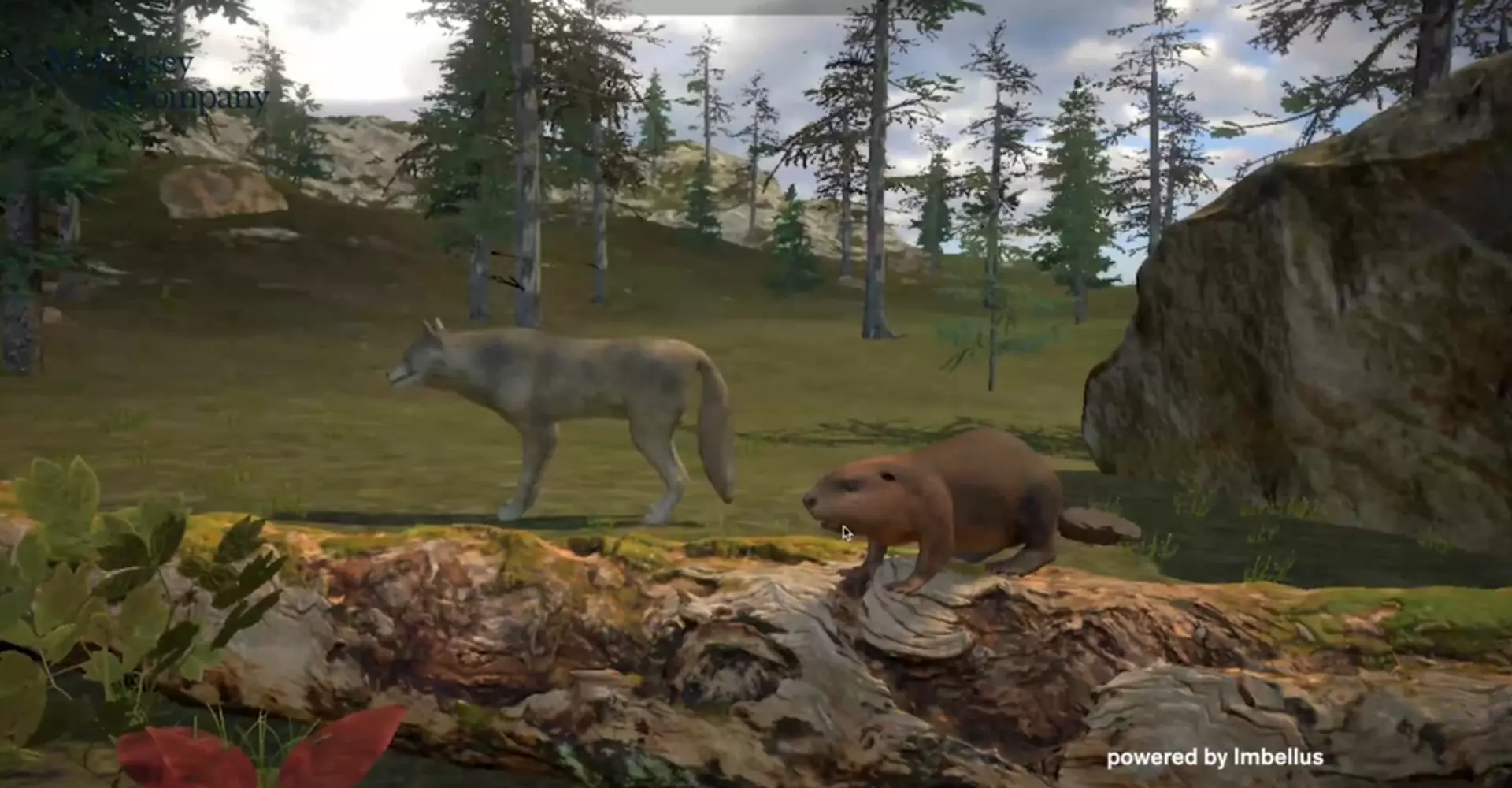
There have been accounts of some test takers being given a third game as part of their Solve assessment. At time of writing, these third games have always been clearly introduced as non-scored beta tests for Imbellus to try out potential new additions to the assessment. However, the fact that these have been tested means that there is presumably a good chance we’ll see them as scored additions in future.
Notably, these alternative scenarios are generally variations on a fairly consistent theme and tend to share a good deal of the character of the Ecosystem Building game. Usually, candidates will be given a whole slew of information on how an animal population has changed over time. They will then have to wade through that information to figure out either which kind of natural disaster or which disease has been damaging that population - the commonality with the Ecosystem Building game being in the challenge of dealing with large volumes of information and figuring out which small fraction of it is actually relevant.
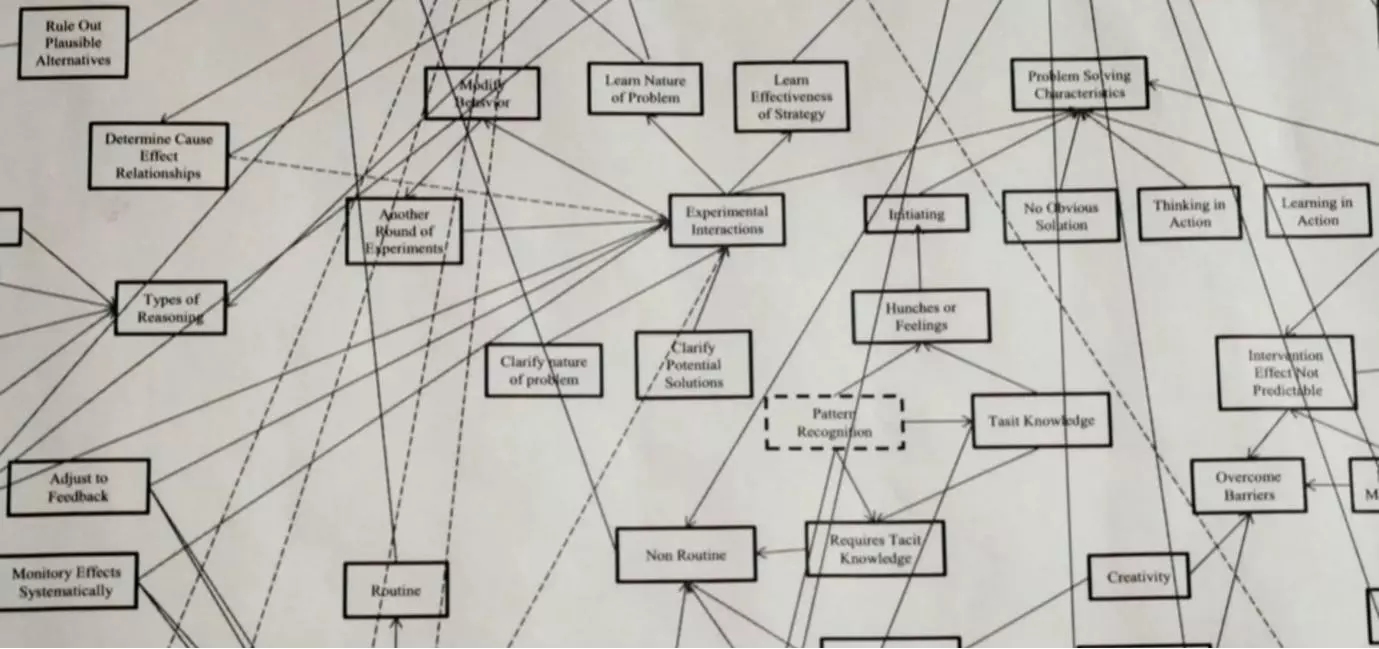
Whilst information on the Solve assessment can be hard to come by, Imbellus and McKinsey have at least been explicit on what traits the test was designed to look for. These are:
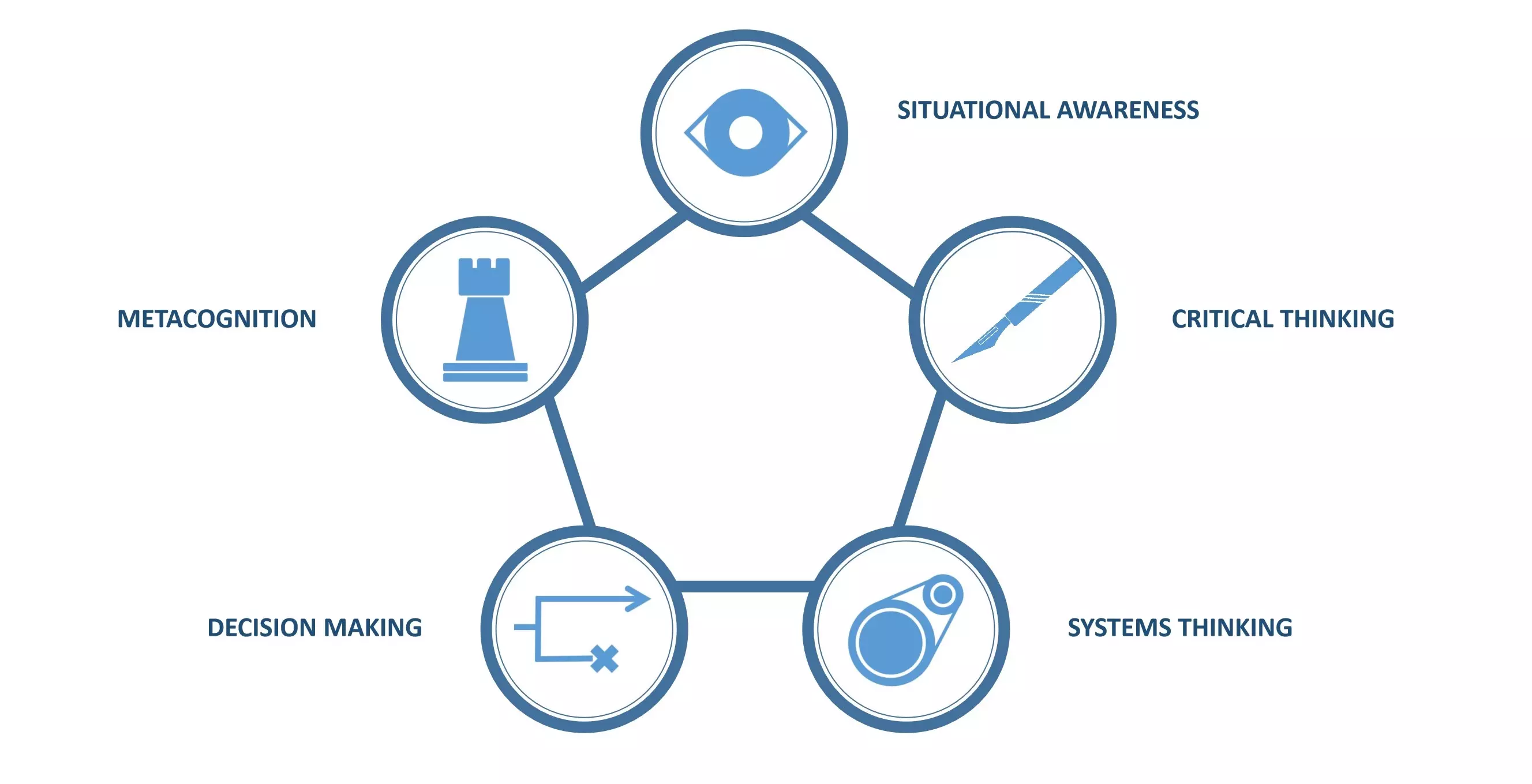
Equally important to understanding the raw facts of the particular skillset being sought out, though, is understanding the very idiosyncratic ways in which the Solve assessment tests for these traits.
Let's dive deeper:
Perhaps the key difference between the Solve assessment and any other test you’ve taken before is Imbellus’s innovation around “process scores”.
To explain, when you work through each of the games, the software examines the solutions you generate to the various problems you are faced with. How well you do here is measured by your “product score”.
However, scoring does not end there. Rather, Solve's software also constantly monitors and assesses the method you used to arrive at that solution. The quality of the method you used is then captured in your “process score”.
To make things more concrete here, if you are playing the Ecosystem Building game, you will not only be judged on whether the ecosystem you put together is self-sustaining. You will also be judged on the way you have worked in figuring out that ecosystem - presumably, on how efficient and organised you were. The program tracks all your mouse clicks and other actions and will thus be able to capture things like how you navigate around the various groups of species, how you place the different options you select, whether you change your mind before you submit the solution and so on.
You can find more detail on these advanced aspects of the Solve assessment and the innovative work behind it in the presentation by Imbellus founder Rebecca Kantar in the first section of the following video:
Compared to other tests, this is far more like the level of assessment you face from an essay-based exam, where the full progression of your argument towards a conclusion is marked - or a maths exam, where you are scored on your working as well as the final answer (with, of course, the major advantage that there is no highly qualified person required to mark papers).
Clearly, the upshot of all this is that you will want to be very careful how you approach the Solve assessment. You should generally try to think before you act and to show yourself in a very rational, rigorous, ordered light.
We have some advice to help look after your process scores in our PDF Guide to the McKinsey Solve Assessment.
Another remarkable and seriously innovative aspect of the Solve assessment is that no two candidates receive exactly the same test.
Imbellus automatically varies the parameters of their games to be different for each individual test taker, so that each will be given a meaningfully different game to everyone else’s.
Within a game, this might mean a different terrain setting, having a different number of species or different types of species to work with or more or fewer restrictions on which species will eat which others.
Consequently, even if your buddy takes the assessment for the same level role at the same office just the day before you do, whatever specific strategy they used in their games might very well not work for you.
This is an intentional feature designed to prevent test takers from sharing information with one another and thus advantaging some over others. At the extreme, this feature would also be a robust obstacle to any kind of serious cheating.
To manage to give every candidate a different test and still be able to generate a reliable ranking of those candidates across a fundamental skillset, without that test being very lengthy, is a considerable achievement from Imbellus. At high level, this would seem to be approximately equivalent to reliably extracting a faint signal from a very noisy background on the first attempt almost every time.
(Note that we are yet to confirm to what extent and how this also happens with the new Redrock case studies, but it seems to be set up to allow for easy changes to be made to the numerical values describing the case, so we assume there will be similar, widespread of variation.)
Understanding what the Solve assessment tests for immediately begs the question as to whether it is possible to usefully prepare and, if so, what that preparation should look like.

In short, yes you can - and you should!
As noted previously, there has been a lot of disagreement over whether it is really possible to prep for the Solve assessment in a way that actually makes a difference.
Especially for the legacy version, there has been a widespread idea that the Solve assessment functions as something like an IQ test, so that preparation beyond very basic familiarisation to ensure you don’t panic on test day will not do anything to reliably boost your scores (nobody is going to build up to scoring an IQ of 200 just by doing practice tests, for example).
This rationale says that the best you can do is familiarise yourself with what you are up against to calm your nerves and avoid misunderstanding instructions on test day. However, this school of thought says there will be minimal benefit from practice and/or skill building.
The utility of preparation has become a clearer with the addition of the Redrock case study to the new version of Solve. Its heavily quantitative nature, strong time pressure and structure closely resembling a traditional business case make for a clearer route to improvement.
However, as we explain in more detail in our PDF guide to the Solve assessment, the idea that any aspect of either version of Solve can't be prepared for has been based on some fundamental misunderstandings about what kind of cognitive traits are being tested. Briefly put, the five key skills the Solve assessment explicitly examines are what are known as higher-order thinking skills.
Crucially, these are abilities that can be meaningfully built over time.
McKinsey and Imbellus have generally advised that you shouldn’t prepare. However, this is not the same as saying that there is no benefit in doing so. McKinsey benefits from ensuring as even a playing field as possible. To have the Solve test rank candidates based purely on their pre-existing ability, they would ideally wish for a completely unprepared population.

We discuss how to prep for the Solve assessment in full detail in our PDF guide. Here, though, we can give you a few initial pointers to get you started. In particular, there are some great ways to simulate different games as well as build up the skills the Solve assessment tests for.
Playing video games is great prep for the legacy Solve assessment in particular, but remains highly relevant to the new Redrock version.
Contrary to what McKinsey and Imbellus have said - and pretty unfortunately for those of us with other hobbies - test takers have consistently said that they reckoned the Problem Solving Game, and now the Solve assessment, favours those with strong video gaming experience.
If you listened when your parents told you video games were a waste of time and really don’t have any experience, then putting in some hours on pretty much anything will be useful. However, the closer the games you play are to the Solve scenarios, the better. We give some great recommendations on specific games and what to look for more generally in our Solve guide - including one free-to-play game that our clients have found hugely useful as prep for the plant defence game!
The inclusion of the Redrock case studies in the new version of Solve really represents a return to something like a modernised PST. Along with the similar new BCG Casey assessment, this seems to be the direction of travel for consulting recruitment in general.
Luckily, this means that you can leverage the wealth of existing PST-style resources to your advantage in preparation.
Our PST article - which links to some free PST questions and our full PST prep resources - is a great place to start. We also include PST questions in our McKinsey Solve preparation bundle so that you can practice for the Redrock case as well.
Again, specifically for the Redrock assessment, you will be expected to solve math problems very quickly. The conceptual level of mathematics required is not particularly high, but you need to know what you are doing and get through it fast using a calculator nand/or Excel, if you are already comfortable with that program.
Our article on consulting math is a great place to start to understand what is expected of you throughout the recruiting process, with our consulting math package (a subset of our Case Academy course) providing more in-depth lessons and practice material.
With the Redrock case studies clearly being ecology-themed analogues to standard business case studies, it's pretty obvious that getting good at case studies will be useful.
However, the Solve assessment as a whole is developed and calibrated to be predictive of case interview performance, so you can expect that improving your case solving ability will indirectly bring up your performance across the board.
Of course, this overlaps with your prep for McKinsey's case interviews. For more on how to get started there, see the final section of this article.
The first thing to do is to familiarise yourself with the common game scenarios from the Solve assessment and how you can best approach them to help boost your chances of success.
Now, one thing to understand is that, since the parameters for the games change for each test taker, there might not be a single definitive optimal strategy for every single possible iteration of a particular game. As such, you shouldn’t rely on just memorising one approach and hoping it matches up to what you get on test day.
Instead, it is far better to understand why a strategy is sensible in some circumstances and when it might be better to do something else instead if the version of the game you personally receive necessitates a different approach.
In this article, we have given you a useful overview of the games currently included in the Solve assessment. However, a full discussion with suggested strategies is provided in our comprehensive Solve guide.
With the limited space available here, this is only a very brief sketch of a subset of the ways you can prep.
As noted, what will help with all of these and more is reading the extensive prep guidance in our full PDF guide to the Solve assessment.
Preparing for the Solve assessment doesn’t have to be a matter of stumbling around on your own. This article is a good introduction. From here, though our new, McKinsey Solve Assessment bundle is your first stop to optimise your Solve preparation.
Short answer: yes. If you just think about the financials, a job at McKinsey is worth millions in the long run. If you factor in experience, personal growth and exit opportunities, the investment is a no-brainer. And if this is not enough, we also offer a 30 days money back guaranteed no questions asked.
Don't expect some magic tricks to game the system (because you can't), but rather an in-depth analysis of key areas crucial to boost your scores. This helps you to:
Overall, the MyConsultingCoach Solve bundle provides the tools for an efficient and effective preparation. Our guide is designed to be no-nonsense and straight to the point. It tells you what you need to know up front and - for those of you in a hurry - crucial sections are clearly marked to read first to help you prep ASAP.
Our simulator helps you uncover the fundamental mechanics of the game.
For those of you starting early with more time to spare, there is also a fully detailed, more nuanced discussion in the guide of what the test is looking for and how you can design a more long-term prep to build up the skills you need - and how this can fit into your wider case interview prep.
Importantly, there is no fluff to bulk out the page count. The market is awash with guides at huge page counts, stuffed full of irrelevant material to boost overall document length. By contrast, we realise your time is better spent actually preparing than ploughing through a novel.
If this sounds right for you, you can purchase our PDF Solve bundle here: